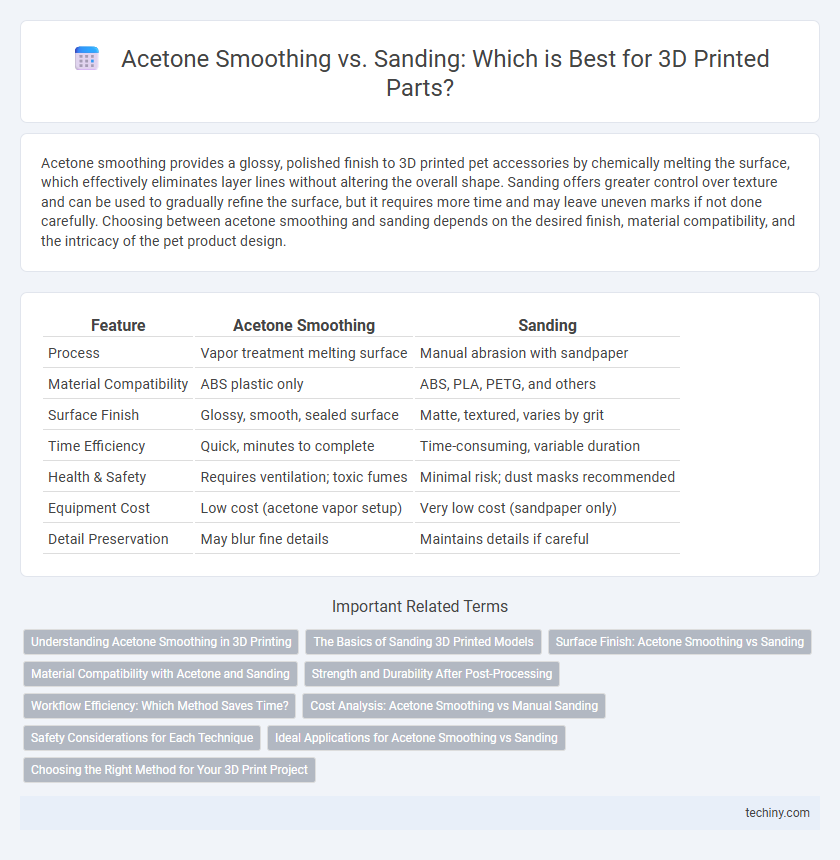Acetone smoothing provides a glossy, polished finish to 3D printed pet accessories by chemically melting the surface, which effectively eliminates layer lines without altering the overall shape. Sanding offers greater control over texture and can be used to gradually refine the surface, but it requires more time and may leave uneven marks if not done carefully. Choosing between acetone smoothing and sanding depends on the desired finish, material compatibility, and the intricacy of the pet product design.
Table of Comparison
| Feature | Acetone Smoothing | Sanding |
|---|---|---|
| Process | Vapor treatment melting surface | Manual abrasion with sandpaper |
| Material Compatibility | ABS plastic only | ABS, PLA, PETG, and others |
| Surface Finish | Glossy, smooth, sealed surface | Matte, textured, varies by grit |
| Time Efficiency | Quick, minutes to complete | Time-consuming, variable duration |
| Health & Safety | Requires ventilation; toxic fumes | Minimal risk; dust masks recommended |
| Equipment Cost | Low cost (acetone vapor setup) | Very low cost (sandpaper only) |
| Detail Preservation | May blur fine details | Maintains details if careful |
Understanding Acetone Smoothing in 3D Printing
Acetone smoothing in 3D printing is a post-processing technique primarily used for ABS plastic to achieve a glossy and smooth surface by dissolving the outermost layer of the print. This method reduces visible layer lines and imperfections more efficiently than sanding, providing a uniform finish without the risk of uneven surfaces or losing fine details. However, acetone smoothing requires careful handling due to the chemical's fumes and potential health hazards, making proper ventilation and safety precautions essential during application.
The Basics of Sanding 3D Printed Models
Sanding 3D printed models involves progressively using finer grit sandpaper to smooth layer lines and surface imperfections, starting typically from 100-200 grit and moving up to 1000-2000 grit for a polished finish. This manual process allows precise control over the texture and shape, making it ideal for delicate details and complex geometries that acetone smoothing might distort. Effective sanding requires patience and careful technique to avoid over-sanding, ensuring the model retains its intended dimensions and structural integrity.
Surface Finish: Acetone Smoothing vs Sanding
Acetone smoothing creates a glossy, uniform surface finish on ABS prints by melting the outer layer, effectively eliminating layer lines and minor imperfections. Sanding offers more control over texture, allowing gradual refinement from coarse to fine grits but can leave subtle scratches or unevenness if improperly done. For a polished, professional appearance, acetone smoothing provides a faster, more consistent result, while sanding is preferred for customized, tactile finishes.
Material Compatibility with Acetone and Sanding
Acetone smoothing is highly effective for ABS plastics due to acetone's solvent properties that dissolve the surface layers, providing a glossy finish; however, it is incompatible with PLA and PETG as these materials do not dissolve in acetone. Sanding is a versatile post-processing technique suitable for a wide range of materials including PLA, ABS, PETG, and nylon, allowing precise surface smoothing without chemical reactions. Choosing between acetone smoothing and sanding depends on the filament type, with acetone smoothing reserved for acetone-soluble plastics and sanding favored for chemically resistant or delicate materials.
Strength and Durability After Post-Processing
Acetone smoothing creates a chemically fused surface layer on ABS prints, enhancing layer adhesion and resulting in higher strength and improved durability compared to sanding. Sanding mechanically removes surface imperfections but can introduce micro-abrasions that may weaken the outer shell and reduce long-term durability. Therefore, acetone smoothing generally offers superior post-processing strength retention for functional 3D printed parts.
Workflow Efficiency: Which Method Saves Time?
Acetone smoothing significantly reduces finishing time by quickly melting and polishing ABS prints in minutes, whereas sanding requires extensive manual effort and multiple grits for a smooth finish. This chemical vapor process eliminates the need for repetitive sanding stages, streamlining workflow efficiency in 3D printing post-processing. Choosing acetone smoothing over sanding can save hours on complex models, accelerating project turnaround.
Cost Analysis: Acetone Smoothing vs Manual Sanding
Acetone smoothing for 3D printed ABS parts involves minimal material cost but requires proper ventilation equipment and safety gear, resulting in moderate upfront expenses. Manual sanding demands only sandpaper and labor, making it low-cost initially but potentially higher in time investment and physical effort, especially for complex geometries. Overall, acetone smoothing presents a cost-effective solution for high-volume or detailed prints, while sanding remains economical for small-scale, straightforward projects.
Safety Considerations for Each Technique
Acetone smoothing involves using acetone vapors to melt and fuse the surface layers of ABS 3D prints, which requires working in well-ventilated areas due to the flammable and toxic nature of acetone fumes. Sanding produces dust particles that can irritate the respiratory system, so wearing a dust mask and eye protection is essential when manually smoothing prints. Both techniques demand proper safety equipment and controlled environments to prevent inhalation hazards and fire risks during post-processing.
Ideal Applications for Acetone Smoothing vs Sanding
Acetone smoothing is ideal for ABS 3D prints requiring a glossy, smooth finish without losing fine details, making it perfect for display models and intricate prototypes. Sanding excels in removing print lines on various filament types like PLA and PETG, suitable for parts that will be painted or require precise dimensional adjustments. Choosing between acetone smoothing and sanding depends on the filament material and the desired surface quality for functional or aesthetic applications.
Choosing the Right Method for Your 3D Print Project
Selecting the optimal finishing method for your 3D print depends on the material and desired surface quality; acetone smoothing is ideal for ABS prints, delivering a glossy, smooth finish by chemically melting the outer layer. Sanding works universally across various filament types like PLA and PETG, allowing precise control over surface texture but requiring more manual effort. Assess your print's material, detail level, and post-processing time to decide between the quick chemical smoothing of acetone or the customizable abrasion of sanding.
Acetone Smoothing vs Sanding Infographic

 techiny.com
techiny.com